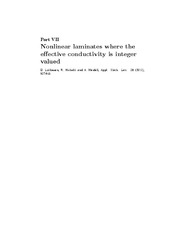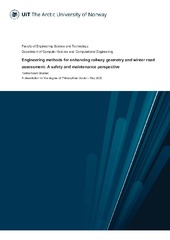| dc.contributor.advisor | Lukkassen, Dag | |
| dc.contributor.author | Høibakk, Ralph | |
| dc.date.accessioned | 2018-04-20T10:15:17Z | |
| dc.date.available | 2018-04-20T10:15:17Z | |
| dc.date.issued | 2017-05-19 | |
| dc.description.abstract | This Ph.D. thesis consists of an introduction and 7 papers where we investigate the requirements for finding integer or rational solutions to a selection of Diophantine equations leading to problems connected to power means and homogenization.
In Paper 1 we present a modern view of classic number theory in a historic context. In Paper 2 we introduce the Crossed Ladders Problem and present a proof of an infinite and complete parametric representation of integer valued solutions to a set of corresponding Diophantine equations. Moreover, we point out a connection between certain classes of the solutions and the Pell numbers series. In Paper 3 we investigate a particular form of the Crossed Ladders Problem, finding many parametrized solutions, some polynomial, and some involving Fibonacci and Lucas sequences. We establish a connection between this particular form and a quartic equation studied by Euler, giving corresponding solutions to the latter. In Paper 4 we study the connection between the crossed ladders problem and certain power means. We prove that we geometrically can construct a number of power means of two variables of different lengths using the crossed ladders geometric structure. In Paper 5 we consider the problem of determining integers a and b such that the corresponding power mean of order k becomes integer valued. By using a variant of Fermat s Last Theorem we show that the problem has no solutions for particular cases. In Paper 6 we study a scale of two-component composite structures of equal proportions with infinitely many microlevels. The structures are obtained recursively and we find that their effective conductivities are power means of the local conductivities. In Paper 7 we consider laminates with a power-law relation between the temperature gradient and the heat flux characterized by some constant. In particular, we discuss the problem of determining what positive integer combinations of the local conductivities and the power which make the effective conductivity integer valued. | en_US |
| dc.description.doctoraltype | ph.d. | en_US |
| dc.description.popularabstract | This Ph.D. thesis consists of an introduction and 7 papers where we investigate the requirements for finding integer or rational solutions to a selection of Diophantine equations leading to problems connected to power means and homogenization. | en_US |
| dc.description | The papers I-VI in this thesis are not available in Munin. <br>
<br>Paper I: Høibakk, R. (2016). A modern view of classic number theory. (Manuscript)
<br>
Paper II: Høibakk, R., Jorstad, T., Lukkassen, D. & Lystad, L.-P. (2008). Integer Crossed Ladders; parametric representation and minimal integer values. Available in Normat 56 (2): 68-79.
<br>
Paper III: Bremner, A., Høibakk, R. & Lukkassen, D. (2009). Crossed ladders and Euler.s quartic. Available in Ann. Math. Inform. 36: 29-41.
<br>
Paper IV. Høibakk, R. & Lukkassen, D. (2008). Crossed ladders and power means. Available in <a href=http://doi.org/10.4171/EM/99 > http://doi.org/10.4171/EM/99 </a> Elem. Math. 63(3):137-140.</a>
<br>
Paper V. Høibakk, R. & Lukkassen, D. (2009). Power means with integer values. Available in <a href=http://doi.org/10.4171/EM/123> http://doi.org/10.4171/EM/123. </a> Elem. Math. 64(3):122-128.
<br>
Paper VI: Meidell, A., Høibakk, R., Lukkassen, D. & Beeri, G. (2008). Two-component composites whose exective conductivities are power means of the local conductivities. Available in <a href=https://doi.org/10.1017/S095679250800747X> https://doi.org/10.1017/S095679250800747X. </a> European J. Appl. Math. 19:507-517. </a>
<br> | en_US |
| dc.identifier.isbn | ISBN 978-82-7823-200-2 | |
| dc.identifier.uri | https://hdl.handle.net/10037/12563 | |
| dc.language.iso | eng | en_US |
| dc.publisher | UiT Norges arktiske universitet | en_US |
| dc.publisher | UiT The Arctic University of Norway | en_US |
| dc.rights.accessRights | openAccess | en_US |
| dc.rights.holder | Copyright 2017 The Author(s) | |
| dc.rights.uri | https://creativecommons.org/licenses/by-nc-sa/3.0 | en_US |
| dc.rights | Attribution-NonCommercial-ShareAlike 3.0 Unported (CC BY-NC-SA 3.0) | en_US |
| dc.subject | VDP::Mathematics and natural science: 400::Mathematics: 410 | en_US |
| dc.subject | VDP::Matematikk og Naturvitenskap: 400::Matematikk: 410 | en_US |
| dc.subject | VDP::Technology: 500::Materials science and engineering: 520::Other material science: 529 | en_US |
| dc.subject | VDP::Teknologi: 500::Materialteknologi: 520::Annen materialteknologi: 529 | en_US |
| dc.subject | VDP::Mathematics and natural science: 400::Mathematics: 410::Applied mathematics: 413 | en_US |
| dc.subject | VDP::Matematikk og Naturvitenskap: 400::Matematikk: 410::Anvendt matematikk: 413 | en_US |
| dc.title | Solutions to some problems related to Diophantine equation, power means and homogenization theory | en_US |
| dc.type | Doctoral thesis | en_US |
| dc.type | Doktorgradsavhandling | en_US |


 English
English norsk
norsk




